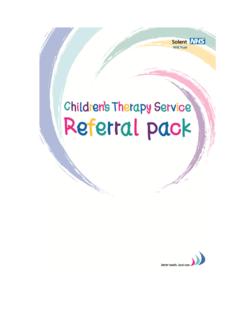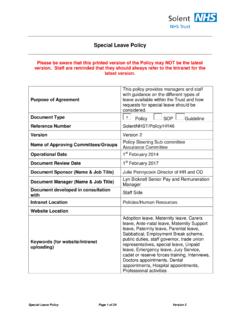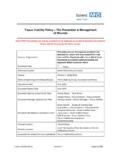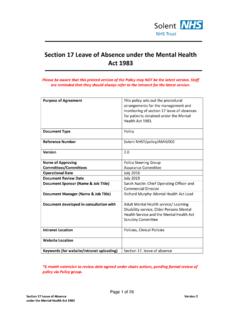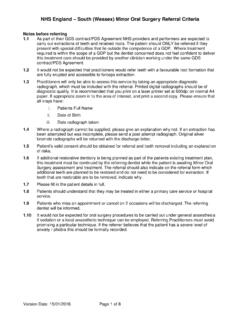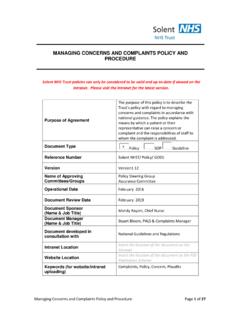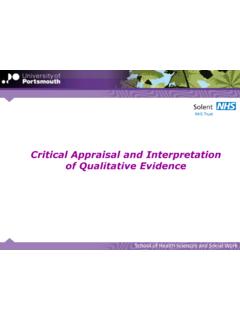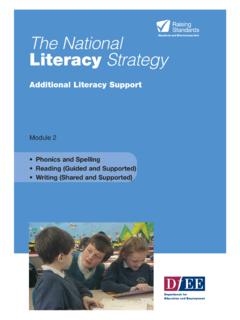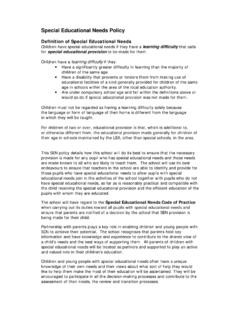Transcription of Schools Therapy Resource Pack - solent.nhs.uk
1 Schools Therapy Resource Pack 2 Acknowledgements The Schools Therapy Resource Pack has been compiled and written by the Solent Children s Therapy Team with significant input from OT School Action produced by the Winchester and Eastleigh Paediatric Occupational Therapy Team, the language Resource Pack for Schools produced by the Basingstoke Speech & language Therapy Team and the Yr R Screening Pack produced by the Winchester and Eastleigh Speech and language Therapy Team. Special thanks go to Jo Johnson for pulling together the initial draft. Many thanks go to everyone who has contributed information, suggestions and content and to the Schools who provided invaluable feedback November 2014 3 Schools Therapy Resource Pack Page Section 1 - Purpose of the Pack 5 Purpose of the Pack Introduction Working together with Schools Definitions of the service Link Therapist information and Photo Information on Telephone advisory service Universal, Targeted, Specialist (UTS) model How to use this pack 6 7 7 10 12 13 14 15 Section 2 - Developmental Information 18 Developing Children s Skills Expected skill level Identifying Functional Difficulties Intervention Record Form 19 23 31 40 Section 3 - Motor Skill Development 45 3a Gross Motor Skills Achieving Body Control (ABC)
2 Clever Bodies 46 65 3b Fine Motor Skills Reception Fine Motor Skills Programme (FMS) Clever Hands 105 116 Section 4 - Speech language and Communication 130 Contents Listening and Attention Understanding language Auditory Memory Descriptive language Skills and Vocabulary Grammar Concepts Sequencing Process of Hypothesis Pragmatic Skills Stammering Voice Phonological Awareness/Working on Speech Sounds DevelopmentalTh Verbal Dyspraxia 131 133 140 152 162 188 225 244 253 266 297 300 301 313 4 Section 5 - Skills for living and learning 318 5a Managing sensory processing difficulties 319 5b Improving visual perceptual skills 322 5c Developing better attention and organisation 327 5d Developing handwriting 336 5e Developing self-care skills 349 Section 6 Glossary 365 Speech, language and Communication definitions 366 Physical skills.
3 Posture and Movement 368 Assessment Terms 377 Conditions 378 Section 7 - Equipment /Resources 379 Items a school might be advised to purchase 382 Specialist Equipment which may be used at school 384 Section 8 Training 386 Free Generic Training 387 Targeted Workshops 388 Section 9 How to refer 391 Referral Checklist 393 Integrated Referral Form 397 Section 10 References 403 Section 11 Appendix 407 Section 1 Purpose of the Pack Section 1 Purpose of the Pack Section 1 Purpose of the Pack 6 Develop or create an environment conducive to learning and developing skills Education staff receive general training from Children s Therapy Services Child identified by school and parent as needing additional support Screening tool used to identify which support is required Use of School Therapy Pack by school / parent Additional Training available from Therapy Services Refer to Therapy Service using integrated Therapy referral form Include information of strategies used and outcome Contact Telephone Advisory Service to discuss Parent takes child to drop in clinic (Availability dependent)
4 Review of skills by school / parent Universal Targeted Specialist Continue Strategies Unresolved difficulties Difficulties have resolved Section 1 Purpose of the Pack 7 Introduction As part of the package of support that the Solent Children s Therapy service gives to children we have developed this Resource pack for Schools The aim is to help Schools provide appropriate and immediate support for children experiencing difficulties. Where a child improves, a referral to the Children s Therapy Service may not be required. However, the activities are not intended to take the place of direct Therapy where it is needed and children should still be referred appropriately to the Children s Therapy Service. [See How to refer , section 9] If after using the advice provided in the pack the child still continues to find tasks hard it may be appropriate for the child to be referred to the Therapy service.
5 The strategies you try can then be used as part of the referral. We have also included a suggested format of how to log the strategies that have been tried. Please see Section 2, page 42. A suggested list of equipment with suppliers may be found in Section 7, page 361. Please feel free to contact us if you have any questions, comments or suggestions about the pack. Working together with Schools Occupational Therapists, Physiotherapists and Speech and language Therapists are concerned with developing children s functional skills in all areas of their daily lives. A major part of their day is spent in school and the curriculum and environment can create many challenges. The main focus for most children s therapists is working in Schools , providing support to education staff and parents.
6 The need for partnership working is highlighted in the The (0-25) Special Educational Needs Code of Practice (Children and Families Bill 2014) . Many children with special educational needs have a range of difficulties and the achievement of educational objectives is likely to be delayed without partnership in the child s education between all concerned ( ). All services should aim to provide an integrated seamless service, keep each other fully informed and help each other in various ways. Alongside other services, support for children with special educational needs requires a concerted approach from healthcare professionals ( ). The Children s National Service Framework 2004 reiterates the importance of good collaborative arrangements between therapists and other professionals.
7 For children with special educational needs, taking part fully in school life, whether in mainstream or special Schools , requires good communication between health, social care and education services so that the child s needs are understood and met. The right school policy or approach can transform the life of these children (NSF Standard 8: , ). Section 1 Purpose of the Pack 8 With improvements in newborn survival rates, greater recognition of developmental disorders and increasing inclusion, the resources of children s Therapy teams are becoming increasingly stretched. Early identification of difficulties and appropriate provision cannot be over emphasised. The earlier action is taken the more responsive the child is likely to be (SEN Code of Practice, ). It is vital to identify quickly and accurately where children and young people have SEN that requires additional support so that this can be put in place.
8 (SEN code of Practice, 2014; ) The benefits of early identification are widely recognised; identifying need at the earliest point that a physical, sensory, learning or mental health need presents itself, and then providing good interventions, improves long-term outcomes for the child. (SEN code of Practice, 2014; ) Improving partnership across different services for children and young people with SEN or disabilities. (SEN code of Practice, 2014; ) All teachers need to be equipped to teach children and young people with a diverse range of need. Early years providers, Schools and colleges should plan their staff training, development and support to ensure all teachers are able to do this. (SEN code of Practice, 2014; ) The educational setting should have a clear approach to assessing SEN which is known by all staff.
9 This should include the use of effective tools and early assessment materials, as well as arrangements to draw on more specialised assessments from external agencies and professionals. (SEN code of Practice, 2014; ) Children with the most severe difficulties are usually identified and receive Therapy at pre-school but the needs of others may not become evident until they start school. When a child is identified as not making adequate progress the school should provide interventions that are additional to or different from those provided as part of the school s usual differentiated curriculum and offer strategies ( ). With this in mind, the Children s Therapy Service has developed this pack to help meet children s needs more effectively in the context of partnership working. The need to support children with speech and language difficulties Speech, language and communication needs (SLCN) are the most common type of special educational need in primary-aged children.
10 On average, in each primary school class, there are two or three children who have SLCN. Providing effective intervention to support children with SLCN is essential, as having a speech, language and communication need can have a significant impact on a child s future: 60% of young offenders have a SLCN, only 25% of children with SLCN reach the expected levels for their age in both English and Maths at the end of key stage 1 and only 10% get five good GCSEs including English and Maths. Early intervention for Section 1 Purpose of the Pack 9 these children is key. Children whose language difficulties were resolved by 5 are more likely to catch up with their peers and pass as many GCSEs as children without a history of language The benefits of school-based management Key bodies interested in speech, language and communication needs (SLCN), including the UK government have conducted much research into best practice for supporting children with SLCN.
